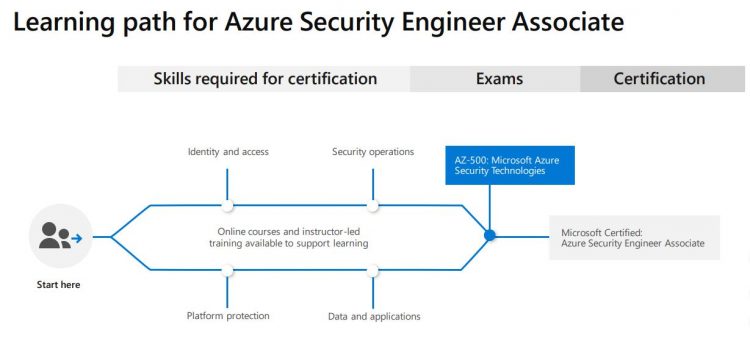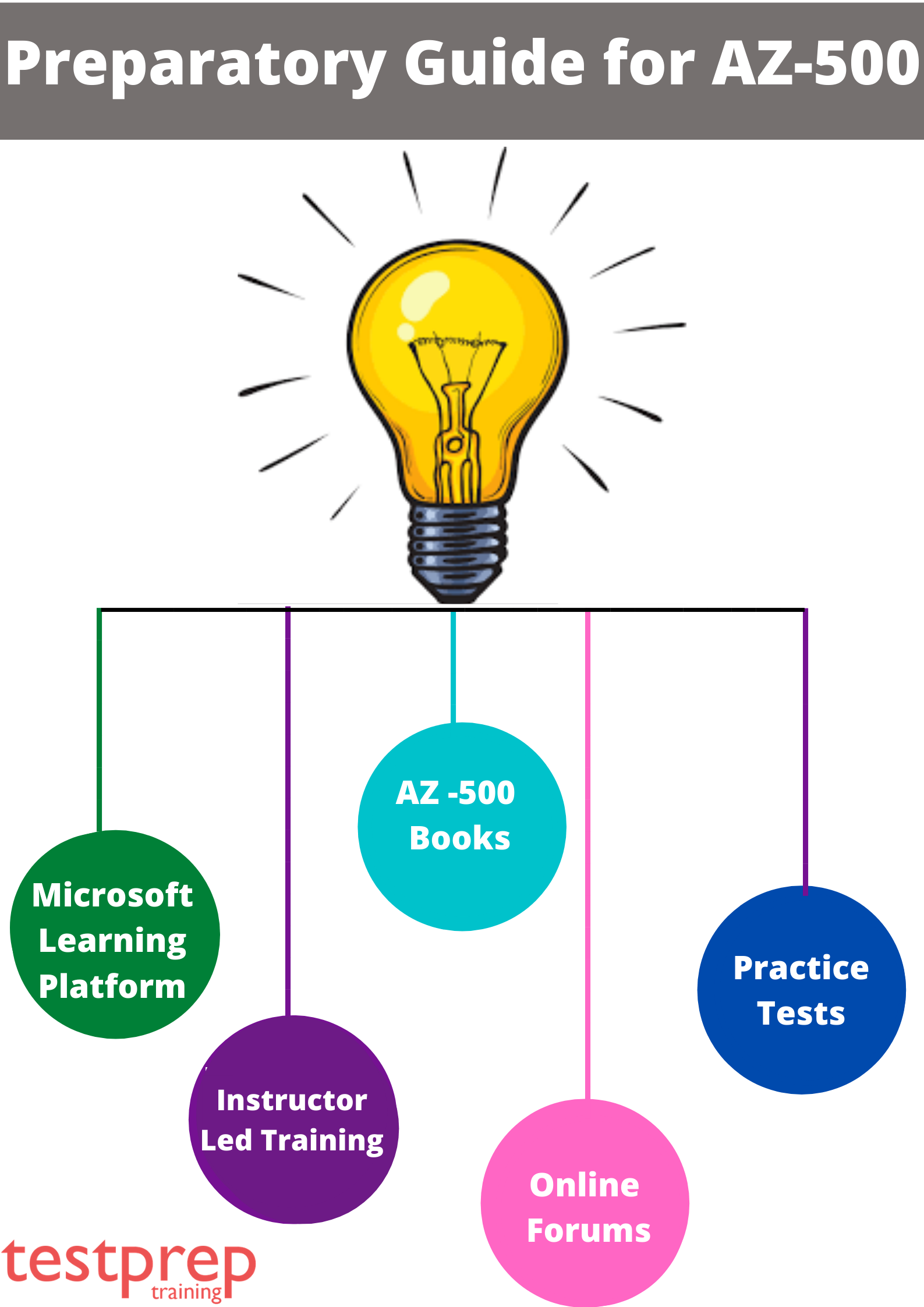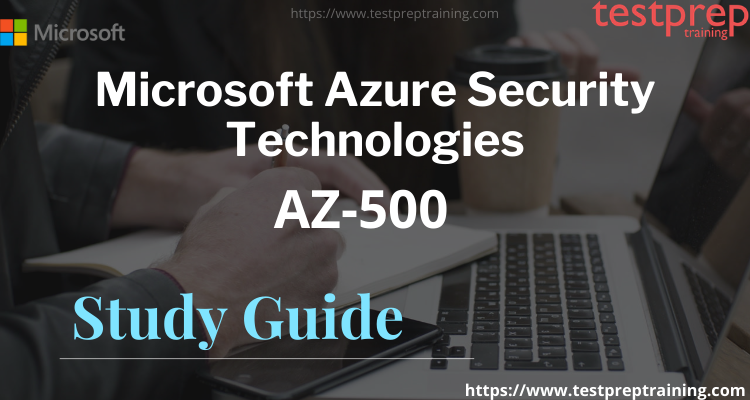Microsoft Azure Security Technologies AZ-500 exam checks if you can do technical tasks like handling who gets access, protecting the platform, running security operations, and keeping data and apps secure. This exam is for people in charge of making sure Microsoft Azure is safe, controlling who can use it, keeping data and apps safe, and managing security.
Overview of AZ-500 Exam
Microsoft Azure Security Technologies (AZ-500) is a certification exam for professionals seeking to demonstrate their knowledge of securing data, devices, and infrastructure in Microsoft Azure. The exam covers a range of security topics, including identity and access management, platform protection, and security management. Target audience for the Microsoft Azure AZ-500 certification exam includes-
- Firstly, those candidates who aspire to make their careers in the tech field.
- Then professionals who want to gain an understanding of Azure fundamentals.
- Further, the individuals who have prior knowledge of advanced security.
- Also, those who have prior working experience with Microsoft Azure.
Basic terms to get familiar with:
Here are some basic terms that are commonly associated with the AZ-500 exam:
- Azure Active Directory (Azure AD): Azure AD is Microsoft’s online service for handling who can access what. It helps organizations control user identities and access to things in Azure and other Microsoft services.
- Network Security Group (NSG): An NSG is a firewall that allows or blocks traffic to virtual machines or subnets in Azure. It uses rules to control inbound and outbound traffic.
- Azure Key Vault: Azure Key Vault is a cloud-based service that allows organizations to store and manage cryptographic keys, certificates, and secrets used in their applications and services.
- Security Center: Security Center is a built-in Azure service that provides a unified view of security across an organization’s Azure resources. It provides security recommendations and alerts to help organizations identify and mitigate potential security threats.
- Azure Information Protection (AIP): AIP is a cloud-based service that allows organizations to classify, label, and protect their sensitive data using encryption and access controls. It integrates with Azure AD to provide identity-based access to protected data.
- Security and Compliance Center: Security and Compliance Center is a centralized portal that provides a unified view of an organization’s compliance status across Microsoft services, including Azure. It provides tools to help organizations manage their compliance and security policies.
Learning Objectives – Microsoft Azure AZ-500
Microsoft certification is a well-known player in the field of cloud computing. This particular vendor states pertinent details on the different domains included in a specific certification exam. As a result, you are easily able to locate the required detailed information along with the subtopics included in each domain. The AZ-500 exam focuses on four key areas:
- Firstly, manage identity and access
- Secondly, Implement platform protection
- Also, Manage security operations
- Finally, Secure data and applications

Study Guide – Microsoft Azure AZ-500 Exam
Preparations for this exam are a huge task given its vast syllabus. You must have access to authentic study resources during your preparation journey. Moreover, this exam is a stepping stone to your dream career therefore, you should prepare with all your focus. The Microsoft Azure AZ-500 exam is designed to test your knowledge and skills in securing Microsoft Azure. The exam covers various areas such as:
- Management of identity and access: covers Azure Active Directory (AD) concepts, Multi-Factor Authentication (MFA), Azure AD Identity protection, etc.
- Platform protection: covers Virtual network protection, network security groups, Azure AD Domain Services, etc.
- Security operations: covers security incident management, security event logging, threat protection, etc.
- Data and application protection: covers encryption, Azure Key Vault, Azure Information Protection, Azure Security Center, etc.
It is recommended to have hands-on experience with Azure and its security services before appearing for the exam. You can refer to the official Microsoft Azure Security Technologies (AZ-500) certification page for more details and study resources.
Here is a step-by-step AZ-500 study guide to get the most from your efforts in exam preparation.

Refer the Exam Objectives
First and foremost, you need to be fully aware of the regulations and guidelines for the test. To perform well in the test, you should familiarize yourself with the topics and course material. Also, it is crucial for your preparations that you design your study schedule around the exam goals. You must give each of the four domains this exam covers ample time. The AZ-500 subjects cover
Manage identity and access (25–30%)
Manage Microsoft Entra identities
- Secure Microsoft Entra users
- Secure Microsoft Entra groups
- Recommend when to use external identities (Microsoft Documentation: External Identities in Azure Active Directory)
- Secure external identities
- Implement Microsoft Entra ID Protection
Manage Microsoft Entra authentication
- Implementing multi-factor authentication (MFA) (Microsoft Documentation: Azure AD Multi-Factor Authentication)
- Configure Microsoft Entra Verified ID
- Implement passwordless authentication (Microsoft Documentation: Enable passwordless sign-in with Microsoft Authenticator)
- Implement password protection (Microsoft Documentation: Enforce on-premises Azure AD Password Protection for Active Directory Domain Services)
- Implementing single sign-on (SSO) (Microsoft Documentation: What is single sign-on in Azure Active Directory?)
- Integrate single sign on (SSO) and identity providers
- Recommend and enforce modern authentication protocols (Microsoft Documentation: Block legacy authentication with Azure AD with Conditional Access)
Manage Microsoft Entra authorization
- Configure Azure role permissions for management groups, subscriptions, resource groups, and resources (Microsoft Documentation: What are Azure management groups)
- Assign Microsoft Entra built-in roles
- Assign built-in roles in Azure
- Create and assign custom roles, including Azure roles and Microsoft Entra roles
- Implement and manage Microsoft Entra Permissions Management (Microsoft Documentation: What’s Permissions Management?)
- Configure Microsoft Entra Privileged Identity Management
- Configure role management and access reviews by using Microsoft Entra (Microsoft Documentation: What are access reviews?)
- Implement Conditional Access policies (Microsoft Documentation: What is Conditional Access?)
Manage Microsoft Entra application access
- Manage access to enterprise applications in Microsoft Entra ID, including OAuth permission grants (Microsoft Documentation: Grant tenant-wide admin consent to an application)
- Manage Microsoft Entra app registrations
- Configure app registration permission scopes (Microsoft Documentation: Introduction to permissions and consent)
- Managing app registration permission consent (Microsoft Documentation: Configure how users consent to applications)
- Manage and use service principals (Microsoft Documentation: Application and service principal objects in Azure Active Directory)
- Manage managed identities for Azure resources (Microsoft Documentation: What are managed identities for Azure resources?)
- Recommend when to use and configure an Microsoft Entra Application Proxy, including authentication
Secure networking (20–25%)
Plan and Implement security for virtual networks
- Plan and implement Network Security Groups (NSGs) and Application Security Groups (ASGs) (Microsoft Documentation: Application security groups, Network security groups)
- Plan and implement user-defined routes (UDRs)
- Planning and implement VNET peering or VPN gateway (Microsoft Documentation: Configure a VNet-to-VNet VPN gateway connection by using the Azure portal)
- Plan and implement Virtual WAN, including a secured virtual hub (Microsoft Documentation: What is a secured virtual hub?)
- Secure VPN connectivity, including point-to-site and site-to-site (Microsoft Documentation: About Point-to-Site VPN, Create a site-to-site VPN connection)
- Implement encryption over ExpressRoute (Microsoft Documentation: ExpressRoute encryption)
- Configure firewall settings on PaaS resources (Microsoft Documentation: Configure Azure Storage firewalls and virtual networks)
- Monitor network security by using Network Watcher, including NSG flow logging (Microsoft Documentation: Introduction to flow logs for network security groups, Log network traffic to and from a virtual machine using the Azure portal)
Plan and implement security for private access to Azure resources
- Plan and implement virtual network Service Endpoints (Microsoft Documentation: Virtual Network service endpoints)
- Planning and implement Private Endpoints (Microsoft Documentation: What is a private endpoint?)
- Plan and implement Private Link services (Microsoft Documentation: What is Azure Private Link?)
- Plan and implement network integration for Azure App Service and Azure Functions
- Plan and implement network security configurations for an App Service Environment (ASE) (Microsoft Documentation: Networking considerations for App Service Environment, App Service Environment networking)
- Planning and implement network security configurations for an Azure SQL Managed Instance (Microsoft Documentation: Azure SQL Database and SQL Managed Instance security capabilities, Azure SQL Database security features)
Plan and implement security for public access to Azure resources
- Plan and implement Transport Layer Security (TLS) to applications, including Azure App Service and API Management (Microsoft Documentation: Add and manage TLS/SSL certificates in Azure App Service)
- Plan and implement, and manager an Azure Firewall including Azure Firewall Manager and firewall policies (Microsoft Documentation: What is Azure Firewall Manager?)
- Plan and implement an Azure Application Gateway (Microsoft Documentation: Application Gateway infrastructure configuration)
- Plan and implement an Azure Front Door, including Content Delivery Network (CDN)
- Plan and implement a Web Application Firewall (WAF) (Microsoft Documentation: What is Azure Web Application Firewall?)
- Recommend when to use Azure DDoS Protection Standard (Microsoft Documentation: Azure DDoS Protection)
Secure compute, storage, and databases (20–25%)
Plan and implement advanced security for compute
- Plan and implement remote access to public endpoints, including Azure Bastion and just-in-time (JIT) virtual machine (VM) access (Microsoft Documentation: What is Azure Bastion?, Plan for virtual machine remote access)
- Configure network isolation for Azure Kubernetes Service (AKS) (Microsoft Documentation: Network concepts for applications in Azure Kubernetes Service (AKS))
- Secure and monitor AKS (Microsoft Documentation: Monitoring Azure Kubernetes Service (AKS) with Azure Monitor)
- Configuring authentication for AKS (Microsoft Documentation: Access and identity options for Azure Kubernetes Service (AKS))
- Configure security monitoring for Azure Container Instances (ACIs)
- Configure security monitoring for Azure Container Apps (ACAs)
- Manage access to Azure Container Registry (ACR) (Microsoft Documentation: Azure Container Registry roles and permissions)
- Configure disk encryption, including Azure Disk Encryption (ADE), encryption as host, and confidential disk encryption (Microsoft Documentation: Overview of managed disk encryption options, Azure Disk Encryption for Windows VMs)
- Recommend security configurations for Azure API Management (Microsoft Documentation: Azure security baseline for API Management)
Plan and implement security for storage
- Configure access control for storage accounts (Microsoft Documentation: Authorize access to data in Azure Storage)
- Manage life cycle for storage account access keys (Microsoft Documentation: Optimize costs by automatically managing the data lifecycle)
- Selecting and configure an appropriate method for access to Azure Files (Microsoft Documentation: Mount SMB Azure file share on Windows)
- Select and configure an appropriate method for access to Azure Blob Storage (Microsoft Documentation: Authorize access to blobs using Azure Active Directory, Choose how to authorize access to blob data in the Azure portal)
- Select and configure an appropriate method for access to Azure Tables (Microsoft Documentation: Authorize access to tables using Azure Active Directory)
- Selecting and configure an appropriate method for access to Azure Queues (Microsoft Documentation: Get started with Azure Queue Storage using .NET)
- Select and configure appropriate methods for protecting against data security threats, including soft delete, backups, versioning, and immutable storage (Microsoft Documentation: Store business-critical blob data with immutable storage, Data protection overview)
- Configure Bring your own key (BYOK) (Microsoft Documentation: Bring your own key (BYOK) details for Azure Information Protection)
- Enable double encryption at the Azure Storage infrastructure level (Microsoft Documentation: Enable infrastructure encryption for double encryption of data)
Plan and implement security for Azure SQL Database and Azure SQL Managed Instance
- Enable Microsoft Entra database authentication
- Enable database auditing (Microsoft Documentation: Auditing for Azure SQL Database and Azure Synapse Analytics)
- Identify use cases for the Microsoft Purview governance portal (Microsoft Documentation: What’s available in the Microsoft Purview governance portal?)
- Implement data classification of sensitive information by using the Microsoft Purview governance portal (Microsoft Documentation: Data classification in the Microsoft Purview governance portal)
- Plan and implement dynamic masking (Microsoft Documentation: Dynamic Data Masking)
- Implement Transparent Database Encryption (TDE) (Microsoft Documentation: Transparent data encryption (TDE))
- Recommend when to use Azure SQL Database Always Encrypted (Microsoft Documentation: Always Encrypted)
Manage security operations (25–30%)
Plan, implement, and manage governance for security
- Create, assign, and interpret security policies and initiatives in Azure Policy (Microsoft Documentation: What is Azure Policy?)
- Configure security settings by using Azure Blueprint (Microsoft Documentation: What is Azure Blueprints?)
- Deploy secure infrastructures by using a landing zone (Microsoft Documentation: What is an Azure landing zone?)
- Create and configure an Azure Key Vault (Microsoft Documentation: About Azure Key Vault)
- Recommend when to use a dedicated Hardware Security Module (HSM) (Microsoft Documentation: What is Azure Dedicated HSM?)
- Configure access to Key Vault, including vault access policies and Azure Role-Based Access Control (Microsoft Documentation: Provide access to Key Vault keys, certificates, and secrets)
- Manage certificates, secrets, and keys (Microsoft Documentation: Azure Key Vault keys, secrets and certificates overview)
- Configure key rotation (Microsoft Documentation: Configure cryptographic key auto-rotation in Azure Key Vault)
- Configure backup and recovery of certificates, secrets, and keys
Manage security posture by using Microsoft Defender for Cloud
- Identify and remediate security risks by using the Microsoft Defender for Cloud Secure Score and Inventory (Microsoft Documentation: Security posture for Microsoft Defender for Cloud)
- Assess compliance against security frameworks and Microsoft Defender for Cloud (Microsoft Documentation: Improve your regulatory compliance)
- Add industry and regulatory standards to Microsoft Defender for Cloud
- Add custom initiatives to Microsoft Defender for Cloud (Microsoft Documentation: Create custom Azure security initiatives and policies)
- Connect hybrid cloud and multi-cloud environments to Microsoft Defender for Cloud (Microsoft Documentation: What is Microsoft Defender for Cloud?)
- Identify and monitor external assets by using Microsoft Defender External Attack Surface Management
Configure and manage threat protection by using Microsoft Defender for Cloud
- Enable workload protection services in Microsoft Defender for Cloud, including Microsoft Defender for Storage, Databases, Containers, App Service, Key Vault, Resource Manager, and DNS
- Configure Microsoft Defender for Servers (Microsoft Documentation: Onboard Windows servers to the Microsoft Defender for Endpoint service)
- Configure Microsoft Defender for Azure SQL Database (Microsoft Documentation: Microsoft Defender for SQL)
- Manage and respond to security alerts in Microsoft Defender for Cloud (Microsoft Documentation: Manage and respond to security alerts in Microsoft Defender for Cloud)
- Configure workflow automation by using Microsoft Defender for Cloud
- Evaluate vulnerability scans from Microsoft Defender for Server (Microsoft Documentation: Defender for Cloud’s integrated Qualys vulnerability scanner for Azure and hybrid machines)
Configure and manage security monitoring and automation solutions
- Monitor security events by using Azure Monitor (Microsoft Documentation: Azure Monitor overview)
- Configure data connectors in Microsoft Sentinel (Microsoft Documentation: Microsoft Sentinel data connectors)
- Create and customize analytics rules in Microsoft Sentinel (Microsoft Documentation: Create custom analytics rules to detect threats)
- Evaluate alerts and incidents in Microsoft Sentinel (Microsoft Documentation: Investigate incidents with Microsoft Sentinel)
- Configure automation in Microsoft Sentinel
Learning Resource 1: Microsoft Learning Platform
Once you make up your mind to appear for the AZ-500 exam, the very next step should be a visit to the Microsoft official site. This official page provides trustworthy and updated information about the exam. A mandatory visit to the official AZ-500 page on the Microsoft website is the ideal place to start your AZ-500 exam preparation.
Learning Source 2: Instructor Led Training
Instructor-led training is like an online class taught by experts or certified instructors. It’s a great option for busy folks because it’s very flexible. You can pick the times that work best for you. Plus, with this kind of training, you can focus on the areas where you’re not so strong, which makes it easier to pass the exam. The Training offered by microsoft for this course is Course AZ-500T00-A: Microsoft Azure Security Technologies
Learning Resource 3: AZ-500 Books

Books are a crucial part of getting ready for certification. They’ve been around for a long time and are a really effective way to study for the exam. There are lots of AZ-500 books available, and using them can really boost your preparation. Here are some popular ones:
- Pro Azure Governance and Security by Peter De Tender
- Microsoft Azure Security Infrastructure by Yuri Diogenes
Learning Resource 4: Online Forums
The best additions to the test preparation method are online forums. Applicants frequently run through challenges and distractions while preparing. Online discussion boards and study groups seem to be the applicants’ best hope at this specific time. You can meet like-minded people who are studying for the AZ-500 and other Azure certification tests by joining community centers. You can maintain your focus on the main goal by taking use of the additional assistance provided by the community.
Attempt Practice Test
The next piece of advice for your study guide involves AZ-500 practice exams. By simulating an actual test, practice exams help students by enhancing their preparation. They offer prompt results and thorough performance reports, which enable candidates to identify their areas of strength and weakness across several fields. Also, take several practice exams to keep an eye on your preparedness. Your confidence will therefore increase, and you’ll be prepared for exams. Start Practising Now!
Exam Tips:
Here are some tips that could help you prepare and succeed in the Microsoft Azure AZ-500 exam:
- Study the official Microsoft Azure Security Technologies (AZ-500) certification page and understand the exam objectives and format.
- Get hands-on experience with Azure and its security services. The more you practice, the better you will understand the concepts and scenarios.
- Use Microsoft’s official study resources like the Azure Security Center, Azure documentation, and online courses.
- Join online forums and connect with other certified professionals to learn from their experiences and exchange study tips.
- Practice with sample exams and test your knowledge regularly.
- Keep yourself informed about the newest security threats and the best ways to do things in the field.
- Take notes and review them regularly to reinforce your understanding of the concepts.
- Plan your study schedule and stick to it. Make sure you allocate enough time for each topic.



